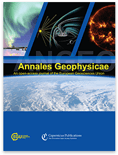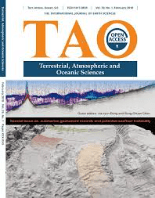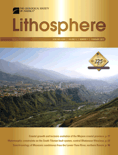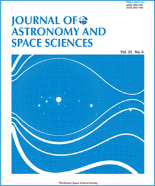
EARTH PLANETS AND SPACE
metrics 2024
Pioneering Research in Earth and Space Sciences
Introduction
EARTH PLANETS AND SPACE, published by Springer and based in Switzerland, is a distinguished journal that plays a pivotal role in advancing the fields of Earth and planetary sciences. With an impactful presence in both geology (Q1) and space and planetary science (Q2), this journal is increasingly recognized for its contributions to understanding complex geoscientific processes and extraterrestrial phenomena. The journal has been a vital resource for researchers since its inception in 1996 and is anticipated to continue this legacy until at least 2024. It ranks impressively within the Scopus database, holding the 53rd position out of 321 in Earth and Planetary Sciences for Geology and the 30th position out of 104 for Space and Planetary Science, reflecting a robust percentile standing of 83 and 71, respectively. With open access options available, EARTH PLANETS AND SPACE makes cutting-edge research more accessible to a global audience, fostering collaboration and innovation. This journal is essential for anyone seeking to deepen their knowledge or stay current with trends in Earth sciences and planetary exploration.
Metrics 2024
 -
- 3.00
3.00 2.90
2.90 -
-Metrics History
Rank 2024
IF (Web Of Science)
JCI (Web Of Science)
Quartile History
Similar Journals

AGU Advances
Championing High-Quality, Interdisciplinary ScienceAGU Advances, published by the American Geophysical Union, is a premier Open Access journal established in 2020, dedicated to advancing the field of Earth and Planetary Sciences. With an impressive Q1 ranking in the 2023 category of Earth and Planetary Sciences (miscellaneous) and a Scopus rank of #81/195, it serves as a vital platform for researchers, professionals, and students to share their findings and innovations. The journal fosters a collaborative environment, encouraging interdisciplinary approaches and high-quality research that addresses the fundamental questions of our planet and beyond. With its commitment to accessibility, AGU Advances ensures that cutting-edge research is available to a global audience, supporting the dissemination of knowledge that is crucial for addressing current and future scientific challenges. For those keen on contributing to or accessing groundbreaking studies in this dynamic field, AGU Advances is an invaluable resource.

EARTH MOON AND PLANETS
Unveiling Celestial Mysteries: Insights from Earth to the Moon and PlanetsEARTH MOON AND PLANETS, published by Springer, serves as a vital platform for researchers and professionals in the interdisciplinary fields of astronomy, planetary science, and earth sciences. With an ISSN of 0167-9295 and E-ISSN of 1573-0794, this journal has been disseminating knowledge since 1984 and continues to provide valuable insights into the complexities of celestial bodies and their interactions. Although currently ranked in the Q4 quartile across its relevant categories, including Astronomy and Astrophysics, Earth and Planetary Sciences, and Space and Planetary Science, the journal remains committed to fostering academic discourse and innovation in its field. Located in the Netherlands, at VAN GODEWIJCKSTRAAT 30, 3311 GZ DORDRECHT, the journal offers an array of research articles designed to inspire scholarly exploration and collaboration. Despite not providing open access options, it nevertheless plays a significant role in shaping the discourse around planetary research and is essential reading for anyone looking to deepen their understanding of earth, moon, and planetary sciences.

GEOSCIENCES JOURNAL
Fostering Collaboration in Geosciences for a Greener Tomorrow.Welcome to the GEOSCIENCES JOURNAL, a pivotal publication in the fields of Earth and Planetary Sciences and Environmental Science, proudly presented by the Geological Society of Korea. Established in 1997, this journal has become a prominent platform for researchers, professionals, and students, offering a rich collection of peer-reviewed articles that explore a diverse array of geoscientific topics. With an impressive Q2 ranking in both Earth and Planetary Sciences and Environmental Science categories for 2023, it stands as an essential resource in the academic community. Though it operates under a traditional subscription model, GEOSCIENCES JOURNAL remains dedicated to advancing knowledge through rigorous research. Addressed from its headquarters in Seoul, South Korea, the journal aims to foster a deeper understanding of geosciences, encouraging innovation and collaboration in tackling today’s environmental challenges.

ANNALES GEOPHYSICAE
Innovating Research in Geophysics and Related FieldsANNALES GEOPHYSICAE is a distinguished open access journal published by COPERNICUS GESELLSCHAFT MBH, renowned for its contributions to the field of geophysics and related disciplines. Since its inception in 1996 as an open access journal, ANNALES GEOPHYSICAE has provided a vital platform for researchers to disseminate their findings covering a wide array of topics within Astronomy and Astrophysics, Atmospheric Science, and Earth and Planetary Sciences. The journal enjoys a commendable reputation, evidenced by its impressive 2023 category quartiles, ranking Q1 in Earth and Planetary Sciences (miscellaneous) and Q2 in several other relevant categories, reflecting its significance in the global research community. Based in Germany and accessible to a diverse audience, ANNALES GEOPHYSICAE serves as an essential resource for academics, practitioners, and students alike, striving to foster advancements in our understanding of geophysical phenomena and encouraging collaboration across disciplines.

TERRESTRIAL ATMOSPHERIC AND OCEANIC SCIENCES
Pioneering Discoveries in Terrestrial SciencesTERRESTRIAL ATMOSPHERIC AND OCEANIC SCIENCES, published by SpringerNature, is a distinguished peer-reviewed journal that has been an essential platform for innovative research in the fields of atmospheric science, oceanography, and Earth and planetary sciences since its inception. With an Open Access policy established in 1990, the journal ensures wide dissemination of knowledge, allowing researchers, professionals, and students to access cutting-edge findings without restrictions. Based in Switzerland and featuring a comprehensive coverage from 1996 to 2024, the journal currently holds a Q3 ranking across various categories, indicating its growing significance in the scientific community. Although it is positioned within the 39th percentile in Earth and Planetary Sciences, its commitment to fostering high-quality research makes it a valuable resource for advancing understanding of terrestrial environments and their interconnections. Researchers seeking a platform for their work in atmospheric and oceanic sciences will find TERRESTRIAL ATMOSPHERIC AND OCEANIC SCIENCES to be an ideal venue for sharing their insights with a global audience.

GEOTECTONICS
Charting New Territories in Tectonic Research.GEOTECTONICS is a distinguished academic journal published by PLEIADES PUBLISHING INC, focusing on key developments in the field of geology. Established in 1978, the journal has dedicated itself to exploring the intricate processes and phenomena associated with Earth's tectonic systems, making substantial contributions to Earth and Planetary Sciences. With an impressive impact factor reflected in its Q2 ranking within the Scopus category of Geology, GEOTECTONICS stands out as a valuable resource for researchers, professionals, and students alike. The journal offers a platform for rigorous peer-reviewed research that spans both fundamental theories and practical applications in geosciences, affirming its significance in fostering academic discourse and advancing geological knowledge. Although it currently does not offer open access, the journal's accessible format and continued publication through to 2024 ensures that it remains at the forefront of geoscientific inquiry.

SOLAR SYSTEM RESEARCH
Fostering Innovation in Space and Planetary ScienceSOLAR SYSTEM RESEARCH, published by Pleides Publishing Inc, offers a comprehensive platform for the exploration and dissemination of scientific knowledge in the fields of Astronomy, Astrophysics, and Space and Planetary Science. With its origins tracing back to 1969, this journal provides a vital resource for researchers and professionals seeking to deepen their understanding of the solar system's complexities, including planetary formation, extraterrestrial geology, and the dynamics of celestial bodies. Although categorized in the Q4 quartile for both relevant disciplines, SOLAR SYSTEM RESEARCH remains committed to publishing high-quality research that contributes to advancing contemporary scientific discourse. Dedicated to fostering collaboration and innovation, the journal is indexed in Scopus and adheres to rigorous academic standards, making it an essential resource for students and professionals alike pursuing the latest developments in solar system studies.

Lithosphere
Unveiling the Mysteries of Our Planet's Lithosphere.Lithosphere, published by GEOSCIENCEWORLD, is a premier open access journal that has been at the forefront of geological research since its inception. With the ISSN 1941-8264 and the E-ISSN 1947-4253, this journal serves as a vital resource for researchers, professionals, and students interested in Earth and planetary sciences, particularly in the field of geology. Its impressive ranking of Q2 in the 2023 category indicates its vital role in disseminating high-quality, impactful research. The journal’s commitment to open access since 2018 enhances its reach, providing global accessibility to cutting-edge studies that span a diverse range of geoscientific topics, from tectonics to sedimentology. With Scopus Rank #88 out of 321 in Earth and Planetary Sciences, it offers a strong platform for scholars to share their findings and engage with the latest advancements in the discipline. As the journal continues its convergence from 2009 to 2024, Lithosphere remains a crucial publication for those striving to deepen their understanding of Earth's systems.

Earth and Planetary Physics
Pioneering Discoveries in Space and Planetary ScienceEarth and Planetary Physics, published by SCIENCE PRESS, is a distinguished open-access journal that has been a vital resource for the scientific community since its inception in 2017. With both ISSN and E-ISSN 2096-3955, this journal contributes significantly to the fields of Astronomy and Astrophysics, Atmospheric Science, and Space and Planetary Science, consistently holding a Q2 quartile ranking across these categories as of 2023. Based in the United States, its editorial board consists of renowned experts dedicated to advancing the understanding of planetary phenomena and Earth processes. The journal prides itself on its rigorous peer-review process and broad readership, facilitating the dissemination of cutting-edge research and innovative methodologies. This commitment is reflected in its strong Scopus rankings, positioning it competitively within its scope—rank #33 in Astronomy and Astrophysics and rank #40 in Space and Planetary Science. As an open-access journal, Earth and Planetary Physics is committed to providing free and global access to high-quality research, thereby enhancing visibility and impact for its authors while catering to researchers, professionals, and students eager to explore the intricacies of our planet and beyond.

Journal of Astronomy and Space Sciences
Fostering Collaboration for a Deeper Cosmic Insight.The Journal of Astronomy and Space Sciences, published by the Korean Space Science Society, is a premier open-access platform dedicated to advancing the fields of astronomy, astrophysics, and space sciences. Established in 1984, the journal has been instrumental in disseminating high-quality research findings, fostering collaboration among scientists globally, and providing insights into the dynamics of our universe. With an ISSN of 2093-5587 and an E-ISSN of 2093-1409, the journal has gained notable recognition, currently ranking in the Q3 quartile in Earth and Planetary Sciences and Physics and Astronomy as of 2023. Although the journal's H-Index is currently unspecified, its commitment to rigorous peer-review processes and open-access availability ensures that groundbreaking research is accessible to a wide audience. Based in Seoul, South Korea, the journal is poised to continue supporting innovative research through 2024 and beyond. Researchers, professionals, and students alike will find valuable resources and opportunities within its pages, further establishing this journal as a crucial resource in the exploration of the cosmos.